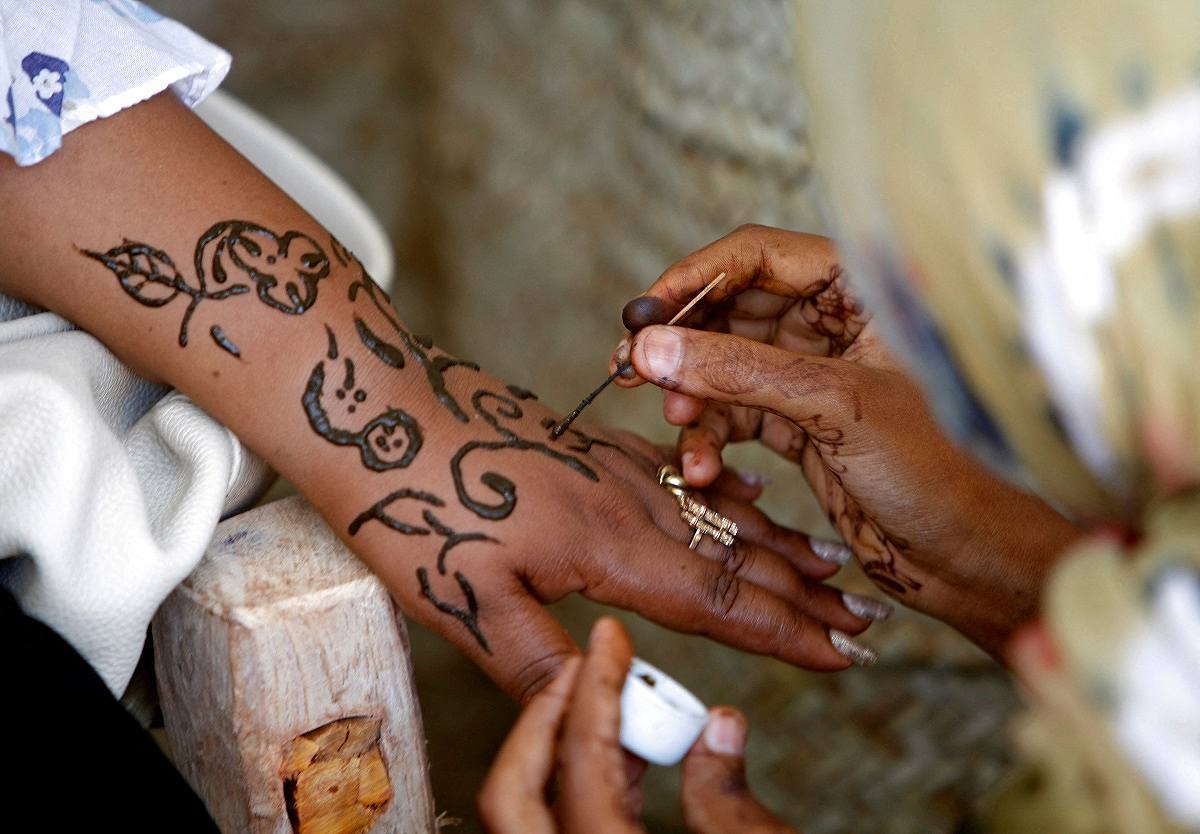
Local women paint each other with henna in Lamu, Kenya, in November 2006.
17:48 JST, April 19, 2023
A study of centuries-old DNA has deciphered the complex ancestry of coastal East Africa’s Swahili people, revealing how a cosmopolitan and prosperous medieval civilization arose thanks in large part to women from Africa and men arriving from Persia.
Researchers said on March 29 they examined the DNA of 80 people from five sites in Kenya and Tanzania dating to about A.D. 1250 to 1800. More than half of the genetic input in many of them traced to female ancestors from Africa’s east coast while a significant contribution also came from Asia, of which about 90% came from men from Persia — modern Iran — and 10% from India.
After around A.D. 1500, the bulk of the Asian genetic contribution shifted to Arabian sources, the study showed.
The Swahili coast region stretches roughly from the Somali capital Mogadishu at the north to Tanzania’s Kilwa island at the south and also includes parts of Kenya and Malawi and the Indian Ocean archipelagoes of Zanzibar and Comoros.
The medieval Swahili people in city-states such as Mombasa and Zanzibar exported goods from the African interior including ivory, gold, ebony and sandalwood, as well as slaves, to destinations across the Indian Ocean. They also were among the first practitioners of Islam among sub-Saharan people.
“The sex-bias in the African-Asian admixture raises questions about the social dynamics and gender roles. On the one hand, you have Persian men mixing with African women, which might highlight social inequalities, usually with the female mixing population of a lower status,” said Harvard University geneticist Esther Brielle, lead author of the study published in the journal Nature.
“However, in this case, because Bantu populations in East Africa often have more matrilineal tendencies, African women likely had more autonomy in choosing their partners for building a family. And the situation could have been that powerful trading families in Africa and Asia formed economically beneficial marriage ties,” Brielle added.
It may be, the researchers said, that the African women and their communities chose to form families with Persian princes or traders, reinforcing trade networks of African and Persian merchants.
People of African and Asian origins began to mix in the region by around A.D. 1000, the study showed. The genetic findings reflected the Swahili people’s cosmopolitan nature. Their Swahili language is of African origin, the predominant religion of Islam was imported from the Middle East and the cuisine shows Indian and Middle Eastern influences.
“The roots of the Swahili language can be traced back over 1,500 years as part of the Bantu language family. This demonstrates the indigenous nature of this society and shows us that the genetic input from Persia was not part of a wholesale population movement,” said study coauthor Stephanie Wynne-Jones, a professor of African archaeology at the University of York in England.
The Swahili culture reached its apex from the 12th to 15th centuries, declining with the arrival of the Portuguese during the 16th century.
“The genetic data provides new information that challenges previous colonial assumptions about the origins of Swahili people and their advances being attributed to foreigners,” Brielle said.
The evidence of Indian ancestry adds a surprising new layer to the history of the East African coast, Brielle added.
There has been a long debate among some scholars over Swahili origins, though modern Swahili people have an oral history embracing both African and Asian roots. For instance, one text based on oral tradition traces the founding of Kilwa to the arrival of a Persian prince.
“It is exciting that the results are consistent with the indigenous oral histories of the Swahili people. These findings bring out the African contributions, and indeed the Africanness of the Swahili without marginalizing the Persian-Indian connection,” University of South Florida anthropologist and study coauthor Chapurukha Kusimba said.
"Science & Nature" POPULAR ARTICLE
-

Genome Study Reveals Milestone in History of Cat Domestication
-

Big Leap in Quest to Get to Bottom of Climate Ice Mystery
-

Security Camera Footage Vulnerable to Outside Access; Investigation Finds 3,000 Pieces Exposed Online
-

Paws on Parade: Nairobi’s Dogs Dazzle at ‘Pawchella’
-

Japan Set to Participate in EU’s R&D Framework, Aims to Boost Cooperation in Tech, Energy
JN ACCESS RANKING
-

Keidanren Chairman Yoshinobu Tsutsui Visits Kashiwazaki-Kariwa Nuclear Power Plant; Inspects New Emergency Safety System
-

Imports of Rare Earths from China Facing Delays, May Be Caused by Deterioration of Japan-China Relations
-

University of Tokyo Professor Discusses Japanese Economic Security in Interview Ahead of Forum
-

Japan Pulls out of Vietnam Nuclear Project, Complicating Hanoi’s Power Plans
-

Govt Aims to Expand NISA Program Lineup, Abolish Age Restriction





















